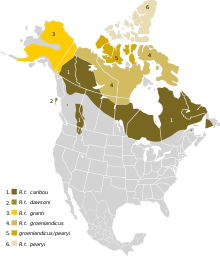Barren-ground caribou
| Barren-ground caribou | |
|---|---|
 |
|
| Barren-ground caribou herd near the Thelon River | |
| Scientific classification | |
| Kingdom: | Animalia |
| Phylum: | Chordata |
| Class: | Mammalia |
| Order: | Artiodactyla |
| Family: | Cervidae |
| Subfamily: | Capreolinae |
| Genus: | Rangifer |
| Species: | R. tarandus |
| Subspecies: | R. t. groenlandicus |
| Trinomial name | |
|
Rangifer tarandus groenlandicus (Borowski, 1780) |
|
 |
|
| Approximate range of barren-ground caribou. Overlap with other subspecies of caribou is possible for contiguous range. 1.Rangifer tarandus caribou subdivided into ecotypes: boreal woodland; migratory woodland; woodland montane; 2. Queen Charlotte Islands (extinct 1907); 3. porcupine; 4. barren-ground; 5. Peary | |
The barren-ground caribou (Rangifer tarandus groenlandicus) is a subspecies of the caribou that is found mainly in the Canadian territories of Nunavut and the Northwest Territories, along with Kitaa, Greenland. It sometimes includes the similar porcupine caribou, in which case the barren-ground caribou is also found in Alaska. The barren-ground caribou is a medium-sized caribou, smaller and lighter coloured than the boreal woodland caribou, with the females weighing around 90 kg (200 lb) and the males around 150 kg (330 lb). However, on some of the smaller islands, the average weight may be less.
In Canada about fifty percent of all caribou are barren-ground caribou.
They spend much or all of the year on the tundra from Alaska to Baffin Island. Most, or about 1.2 million, of the barren-ground caribou in Canada live in eight large migratory herds, which migrate seasonally from the tundra to the taiga, sparsely treed coniferous forests south of the tundra. In order, from Alaska to Hudson Bay, these are the Porcupine herd, Cape Bathurst herd, Bluenose West herd, Bluenose East herd, Bathurst herd, Ahiak herd, Beverly herd, and Qamanirjuaq herd. About 120 000 other barren-ground caribou live in smaller herds that spend the entire year on the tundra. Half of these are confined to Baffin Island.
Like the Peary caribou, both the males and females have antlers. In general, during the summer, the coat of the caribou is brown, and much lighter in the winter. The neck and rump tends towards a creamy-white colour. However, the general colouration may differ depending on the region.
The barren-ground caribou usually breeds in the fall and calves in June but may not drop their single calf until July. Usually the female gives birth away from the herd and if possible on a patch of snow. After birth, the female licks the calf clean and eats the tissues and the placenta. This may serve two purposes, to replace nutrients lost from birthing and to help remove the scent that would attract predators.
The main food source is lichen but they also feed on Cyperaceae (sedges) and other grasses along with twigs and mushrooms. Caribou have also been observed to eat antlers and seaweed and to lick salt deposits. There is some evidence to suggest that on occasion they also feed on lemmings, Arctic char and bird eggs.
...
Wikipedia
